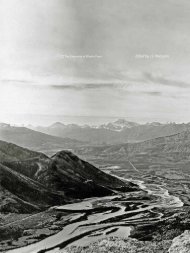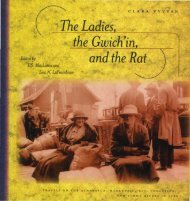Paul Kane's Journal of his Western Travels, 1846-1848 - History and ...
Paul Kane's Journal of his Western Travels, 1846-1848 - History and ...
Paul Kane's Journal of his Western Travels, 1846-1848 - History and ...
Create successful ePaper yourself
Turn your PDF publications into a flip-book with our unique Google optimized e-Paper software.
Coulitz R. The Cowlitz River, a tributary <strong>of</strong> the Columbia,<br />
flows from north to south, joining it fifty-five miles from the<br />
Pacific Ocean. It fonned the inl<strong>and</strong> route from the Columbia<br />
River to Puget Sound. The name, from a tribal name <strong>of</strong><br />
Salishan derivation, means "power," or "catching the<br />
spirit. "<br />
Coupmont de Barge. See boat-incampment.<br />
Cour de lane The Coeur d' Alene Roman Catholic mission was<br />
founded in 1843 (see jochet, Father) on the Spokane River<br />
in what is now the Idaho panh<strong>and</strong>le. A fort <strong>of</strong> the same name<br />
was situated on the Coeur d' Alene River. The Skitswish tribe<br />
came to be known by t<strong>his</strong> French tenn ("heart <strong>of</strong> an awl")<br />
because one <strong>of</strong> its chiefs used it to describe the size <strong>of</strong> a fur<br />
trader's heart.<br />
Crack farm See garden isl<strong>and</strong>.<br />
Crey ICree/Creese Descriptive <strong>of</strong> a wide range <strong>of</strong> hunting<br />
groups speaking the Algonquian language, Cree inhabit, as<br />
they did in <strong>Kane's</strong> day, most areas <strong>of</strong> present-day Quebec,<br />
Ontario, Manitoba (Swampy Cree), Saskatchewan (Woods<br />
Cree <strong>and</strong> Swampy Cree), <strong>and</strong> Alberta (Woods Cree <strong>and</strong><br />
Plains Cree). Kane came into contact with all three divisions<br />
<strong>and</strong> their dialects. The Plains Cree adapted successfully from<br />
woodl<strong>and</strong> trappers to warriors <strong>and</strong> bison hunters, but were<br />
ruined by smallpox <strong>and</strong> the destruction <strong>of</strong> the bison herds.<br />
Cmtey , Mr. Alex<strong>and</strong>er Christie ( 1792 -1872) joined the<br />
HBC in 1809, rising to Chief Factor <strong>and</strong> administrator before<br />
traveling on furlough in <strong>1848</strong>, the year <strong>of</strong> <strong>Kane's</strong> return trip,<br />
to Scotl<strong>and</strong>, where he retired in 1853. He served as Governor<br />
<strong>of</strong> Assiniboia in 1833-1839 <strong>and</strong> 1844-<strong>1848</strong>. During <strong>his</strong><br />
second term, the time <strong>of</strong> <strong>Kane's</strong> visit to Red River, he was<br />
attempting to keep American free-traders from cutting into<br />
the HBC's monopoly on the lower Red River. Governor Simpson's<br />
"Character Book" describes him as "one <strong>of</strong> our best<br />
characters, an honourable, correct, upright good hearted man<br />
as can be found in any Country" (180).<br />
Columba/Columba/Columbia Originally the Rio de San<br />
Rock, in 1792 the Columbia River was explored by the<br />
American Captain Robert Gray, who named it for <strong>his</strong> ship.<br />
Most <strong>of</strong> its 1225 miles <strong>and</strong> 2700-foot drop to sea level were<br />
first paddled in 1811, by David Thompson's North West<br />
Company brigade. Although Thompson discovered it as the<br />
only practicable fur trade route to the Pacific, he met the<br />
Astorians (see Astoria) at the river's mouth, who had anticipated<br />
<strong>his</strong> arrival by some six weeks. Today, thirteen power<br />
dams have altered the river from its character in the midnineteenth<br />
century .<br />
Cumberl<strong>and</strong> Cumberl<strong>and</strong> House (est. 1774) was visited by<br />
Kane June 10, <strong>1848</strong>. The first inl<strong>and</strong> trading post <strong>of</strong> the HBC,<br />
named for Prince Rupert, Duke <strong>of</strong> Cumberl<strong>and</strong> (1619-1687),<br />
Cumberl<strong>and</strong> House was situated on Cumberl<strong>and</strong> Lake, a few<br />
miles north <strong>of</strong> the Saskatchewan River, just west <strong>of</strong> the<br />
modem Manitoba/ Saskatchewan border.<br />
Cwnberl<strong>and</strong> river Rowing southeast out <strong>of</strong> Cumberl<strong>and</strong> Lake,<br />
t<strong>his</strong> river noticeably increases the size <strong>of</strong> the Saskatchewan<br />
River where it enters it from the north, west <strong>of</strong> the modem<br />
Saskatchewan I Manitoba border. The Cumberl<strong>and</strong> fonned<br />
70<br />
part <strong>of</strong> the fur trade route to the north, up the Sturgeon-weir<br />
<strong>and</strong> Churchill River, eventually taking the brigades to the<br />
Athabasca <strong>and</strong> Mackenzie river districts.<br />
daD de more I rapped <strong>of</strong> deth /DaD de More On the upper<br />
Columbia River, above modem Revelstoke, British Columbia,<br />
the Dalle de Mort takes its name from the incident fully<br />
related by Kane.<br />
the DaDs Not to be confused with those on the upper Columbia<br />
River, The Dalles <strong>of</strong> the lower Columbia (at present-day The<br />
Dalles, Oregon) were eight miles <strong>of</strong> rapids named from the<br />
French word for "flagstones." The meaning transfers from<br />
the use <strong>of</strong> such stone to line gutters. To the voyageurs, many<br />
rapids on the fur trade routes resembled such gutters, <strong>and</strong> the<br />
river's rock walls the sides <strong>of</strong> those gutters. The principal<br />
falls <strong>and</strong> rapids below The Dalles were the Little Dalles,<br />
about one mile long, <strong>and</strong> the Cascades. The head <strong>of</strong> The<br />
Dalles was the Great Falls at Celilo; then followed, in upstream<br />
order, Hell Gate Rapids (<strong>Kane's</strong> La Shute [see La<br />
Shute/Shutes/Shoots]) <strong>and</strong> John Day Rapids. It is uncertain<br />
when Kane passed these features during <strong>his</strong> downriver<br />
trip in <strong>1846</strong>, but it is known that on <strong>his</strong> return in 1847 he was<br />
at the Cascades July 3-5, at Hell Gate/Chutes July 8-9, <strong>and</strong><br />
at John Day Rapids July 10 (when WA describes the technique<br />
<strong>of</strong> "tracking" boats up a rapids [184] ).<br />
David Thompson, who descended <strong>and</strong> ascended the Columbia<br />
in the summer <strong>of</strong> 1811 , <strong>of</strong>fered the following succinct<br />
description <strong>of</strong> The Dalles:<br />
These Dalles were ... steep high walls <strong>of</strong> Basalt Rock,<br />
with sudden sharp breaks in them, which were at right<br />
angles to the direction <strong>of</strong> the wall <strong>of</strong> the River, these breaks<br />
formed rude bays, under each point was a violent eddy, <strong>and</strong><br />
each bay a powerful, dangerous, whirpool; these walls <strong>of</strong><br />
Rock contract the River from eight hundred to one thous<strong>and</strong><br />
yards in width to sixty yards, or less: imagination can<br />
hardly fonn an idea <strong>of</strong> the working <strong>of</strong> t<strong>his</strong> immense body <strong>of</strong><br />
water under such a compression, raging <strong>and</strong> <strong>his</strong>sing, as if<br />
alive.<br />
Days Incampment A camp on the Columbia River, ten miles<br />
upriver from Fort Colville.<br />
de gurlay, Frances No further infonnation has surfaced about<br />
t<strong>his</strong> Metis. WA refers to him only as <strong>Kane's</strong> "guide" (64).<br />
de Merse/de Merce, Mr. Modeste Demers (1809-1871) had<br />
gone west from Lower Canada as a Roman Catholic missionary<br />
to Red River in 1837. In 1838, he continued on to Oregon,<br />
working with both voyageurs <strong>and</strong> Indians. After extensive<br />
work in the interior <strong>of</strong> present-day Washington <strong>and</strong> British<br />
Columbia, he was appointed bishop <strong>of</strong> Vancouver Isl<strong>and</strong> in<br />
1'844. When he met Kane in <strong>1848</strong>, Demers was on <strong>his</strong> way to<br />
France to raise funds <strong>and</strong> find missionaries suitable for work<br />
in a territory still with an almost entirely native population.<br />
de Shombo, Mr. George D'Eschambeau1t (1806- 1870) joined<br />
the HBC in 1819 <strong>and</strong> was the Chief Trader stationed atCwnberl<strong>and</strong><br />
House from 1847 to 1849. He did not distinguish himself in<br />
the service <strong>and</strong> never took comm<strong>and</strong> <strong>of</strong> an important post. In <strong>his</strong><br />
"Character Book," Governor Simpson judged him "a well<br />
meaning, well disposed, heavy dull slovenly man, who is deficient<br />
in Education <strong>and</strong> can never be particularly useful. Under-<br />
Guide
















